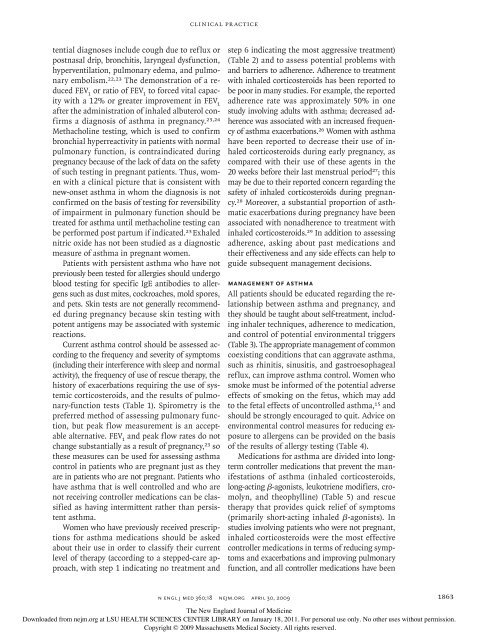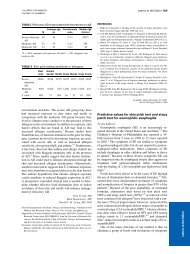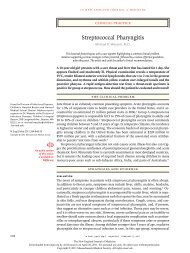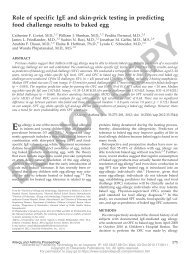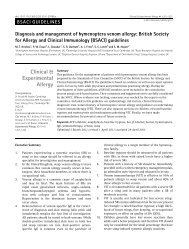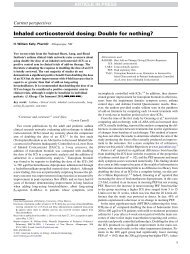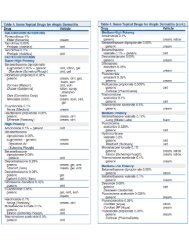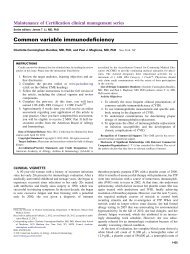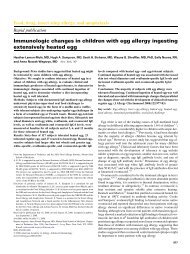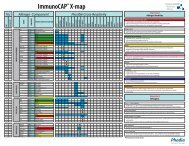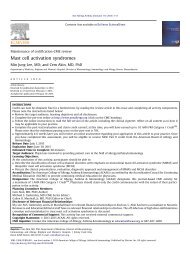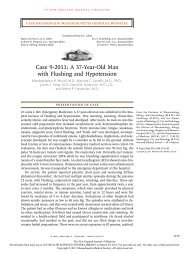Asthma in Pregnancy - NEJM 2009.pdf - AInotes
Asthma in Pregnancy - NEJM 2009.pdf - AInotes
Asthma in Pregnancy - NEJM 2009.pdf - AInotes
Create successful ePaper yourself
Turn your PDF publications into a flip-book with our unique Google optimized e-Paper software.
cl<strong>in</strong>ical practicetential diagnoses <strong>in</strong>clude cough due to reflux orpostnasal drip, bronchitis, laryngeal dysfunction,hyperventilation, pulmonary edema, and pulmonaryembolism. 22,23 The demonstration of a reducedFEV 1 or ratio of FEV 1 to forced vital capacitywith a 12% or greater improvement <strong>in</strong> FEV 1after the adm<strong>in</strong>istration of <strong>in</strong>haled albuterol confirmsa diagnosis of asthma <strong>in</strong> pregnancy. 23,24Methachol<strong>in</strong>e test<strong>in</strong>g, which is used to confirmbronchial hyperreactivity <strong>in</strong> patients with normalpulmonary function, is contra<strong>in</strong>dicated dur<strong>in</strong>gpregnancy because of the lack of data on the safetyof such test<strong>in</strong>g <strong>in</strong> pregnant patients. Thus, womenwith a cl<strong>in</strong>ical picture that is consistent withnew-onset asthma <strong>in</strong> whom the diagnosis is notconfirmed on the basis of test<strong>in</strong>g for reversibilityof impairment <strong>in</strong> pulmonary function should betreated for asthma until methachol<strong>in</strong>e test<strong>in</strong>g canbe performed post partum if <strong>in</strong>dicated. 23 Exhalednitric oxide has not been studied as a diagnosticmeasure of asthma <strong>in</strong> pregnant women.Patients with persistent asthma who have notpreviously been tested for allergies should undergoblood test<strong>in</strong>g for specific IgE antibodies to allergenssuch as dust mites, cockroaches, mold spores,and pets. Sk<strong>in</strong> tests are not generally recommendeddur<strong>in</strong>g pregnancy because sk<strong>in</strong> test<strong>in</strong>g withpotent antigens may be associated with systemicreactions.Current asthma control should be assessed accord<strong>in</strong>gto the frequency and severity of symptoms(<strong>in</strong>clud<strong>in</strong>g their <strong>in</strong>terference with sleep and normalactivity), the frequency of use of rescue therapy, thehistory of exacerbations requir<strong>in</strong>g the use of systemiccorticosteroids, and the results of pulmonary-functiontests (Table 1). Spirometry is thepreferred method of assess<strong>in</strong>g pulmonary function,but peak flow measurement is an acceptablealternative. FEV 1 and peak flow rates do notchange substantially as a result of pregnancy, 23 sothese measures can be used for assess<strong>in</strong>g asthmacontrol <strong>in</strong> patients who are pregnant just as theyare <strong>in</strong> patients who are not pregnant. Patients whohave asthma that is well controlled and who arenot receiv<strong>in</strong>g controller medications can be classifiedas hav<strong>in</strong>g <strong>in</strong>termittent rather than persistentasthma.Women who have previously received prescriptionsfor asthma medications should be askedabout their use <strong>in</strong> order to classify their currentlevel of therapy (accord<strong>in</strong>g to a stepped-care approach,with step 1 <strong>in</strong>dicat<strong>in</strong>g no treatment andstep 6 <strong>in</strong>dicat<strong>in</strong>g the most aggressive treatment)(Table 2) and to assess potential problems withand barriers to adherence. Adherence to treatmentwith <strong>in</strong>haled corticosteroids has been reported tobe poor <strong>in</strong> many studies. For example, the reportedadherence rate was approximately 50% <strong>in</strong> onestudy <strong>in</strong>volv<strong>in</strong>g adults with asthma; decreased adherencewas associated with an <strong>in</strong>creased frequencyof asthma exacerbations. 26 Women with asthmahave been reported to decrease their use of <strong>in</strong>haledcorticosteroids dur<strong>in</strong>g early pregnancy, ascompared with their use of these agents <strong>in</strong> the20 weeks before their last menstrual period 27 ; thismay be due to their reported concern regard<strong>in</strong>g thesafety of <strong>in</strong>haled corticosteroids dur<strong>in</strong>g pregnancy.28 Moreover, a substantial proportion of asthmaticexacerbations dur<strong>in</strong>g pregnancy have beenassociated with nonadherence to treatment with<strong>in</strong>haled corticosteroids. 29 In addition to assess<strong>in</strong>gadherence, ask<strong>in</strong>g about past medications andtheir effectiveness and any side effects can help toguide subsequent management decisions.Management of <strong>Asthma</strong>All patients should be educated regard<strong>in</strong>g the relationshipbetween asthma and pregnancy, andthey should be taught about self-treatment, <strong>in</strong>clud<strong>in</strong>g<strong>in</strong>haler techniques, adherence to medication,and control of potential environmental triggers(Table 3). The appropriate management of commoncoexist<strong>in</strong>g conditions that can aggravate asthma,such as rh<strong>in</strong>itis, s<strong>in</strong>usitis, and gastroesophagealreflux, can improve asthma control. Women whosmoke must be <strong>in</strong>formed of the potential adverseeffects of smok<strong>in</strong>g on the fetus, which may addto the fetal effects of uncontrolled asthma, 15 andshould be strongly encouraged to quit. Advice onenvironmental control measures for reduc<strong>in</strong>g exposureto allergens can be provided on the basisof the results of allergy test<strong>in</strong>g (Table 4).Medications for asthma are divided <strong>in</strong>to longtermcontroller medications that prevent the manifestationsof asthma (<strong>in</strong>haled corticosteroids,long-act<strong>in</strong>g β-agonists, leukotriene modifiers, cromolyn,and theophyll<strong>in</strong>e) (Table 5) and rescuetherapy that provides quick relief of symptoms(primarily short-act<strong>in</strong>g <strong>in</strong>haled β-agonists). Instudies <strong>in</strong>volv<strong>in</strong>g patients who were not pregnant,<strong>in</strong>haled corticosteroids were the most effectivecontroller medications <strong>in</strong> terms of reduc<strong>in</strong>g symptomsand exacerbations and improv<strong>in</strong>g pulmonaryfunction, and all controller medications have beenn engl j med 360;18 nejm.org april 30, 2009 1863The New England Journal of Medic<strong>in</strong>eDownloaded from nejm.org at LSU HEALTH SCIENCES CENTER LIBRARY on January 18, 2011. For personal use only. No other uses without permission.Copyright © 2009 Massachusetts Medical Society. All rights reserved.


